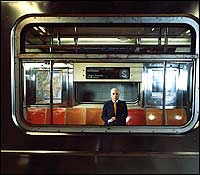Kalikow has done a lot in NYC and has also drawn severe criticism.
From the internet:
Underground Man
Real-estate tycoon Peter Kalikow is rewriting his legacy by presiding over the biggest expansion of New York’s transit system in 60 years. And the Second Avenue subway is only part of the MTA chairman’s plan.
 |
Train Man: MTA Chairman Peter Kalikow in one of his cars. (Photo: Emily Shur) |
“You cannot believe what the weather does to our system,” he says, shaking his head in frustration. “All the maintenance, all the track work, all the attention to detail goes out the goddamned window because of the cold. Unbelievable.”
People often ask him why he subjects himself to the rigors of the chairmanship when he could be doing just about anything else. “I had no idea what I was getting into,” he sometimes smiles and says.
But the truth is more complicated. After surviving a painful, highly public bankruptcy in the early nineties, Kalikow was determined to give something back. The impulse is part altruism, part effort to erase the blot on his record through achievement.
Kalikow likes to say he doesn’t want anything from the job (“What could I want? I have everything”), but, of course, that’s not entirely true. Making money is no longer paramount. “I do this,” he says, “because I want my legacy to be something other than money.”
Though Kalikow has already changed the MTA in significant ways—he’s instituted management reforms to ensure increased accountability and efficiency, and put more transparency in the budget process—he has staked his legacy on expansion. The MTA is about to begin the largest, most far-reaching construction of public-transportation facilities in the city in more than 60 years. It is the kind of infrastructure-building program that will dramatically affect life in New York for decades.
Kalikow believes his experience as a developer has uniquely prepared him for this challenge. He knows how to manage megaprojects (“I’ve been known to have the ability to make sure people do what they’re supposed to when I want something done”) and has the vision to see and understand what the construction will mean to New York 30 or 40 years from now. “They left us a system that’s gone 60 years without expansion,” he says. “And in truth, we weren’t ready to expand. We didn’t really know how to run a system. Now we’ve proved we can do it, and that’s why we can ask for the money. It’s time.”
First up is what’s referred to as East Side Access. At a cost of $6.3 billion, this project will enable Long Island Rail Road trains to go directly into Grand Central Terminal. Right now, 40 percent of all LIRR riders are forced to backtrack to get to the East Side once they reach Penn Station. In addition to saving commuter time and energy, East Side Access would ease the burden on buses, subways, and taxis.



No comments:
Post a Comment
Please leave a comment-- or suggestions, particularly of topics and places you'd like to see covered